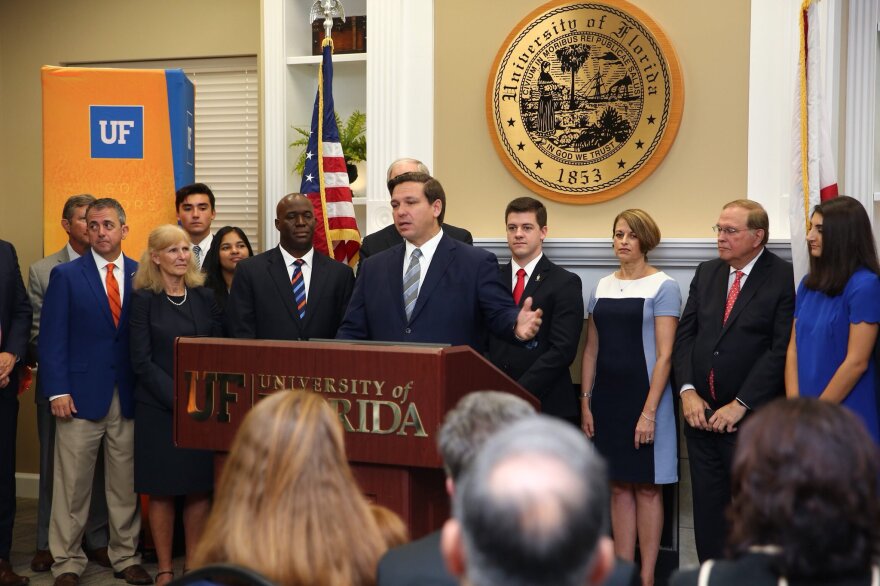Gov. Ron DeSantis, state lawmakers and university officials are bragging about the University of South Florida, Florida State University and the University of Florida moving up in the rankings of an annual report that grades the country's top public colleges and universities.
The news of the universities’ improved status in the U.S. News & World Report’s “2020 Best Colleges” prompted the governor to visit UF and FSU - but not USF - Monday morning to tout their success.
USF posted its best result ever - tied for 44th, up 14 spots from a year earlier. University officials point out that the school was No. 88 in 2015, calling the improvement "an unparalleled trajectory."
“Our new ranking affirms USF’s position as one of the most promising universities in the nation. As USF is increasingly recognized as a destination for exceptionally talented students and faculty, it provides great benefits to the Tampa Bay region and the state of Florida,” said USF President Steven Currall. “We will continue our strategic focus on initiatives that will help propel USF to even greater heights in the future.”
USF has seen its six-year graduation rate climb 25 percent from 2008 to 2018, the largest increase of any U.S. public university.
Appearing at FSU in Tallahassee Monday morning, DeSantis lauded that school’s “remarkable ascent” since 2016, when it ranked 43rd in the nation among state universities. This year, the institution was named the country’s 18th-best public university.
“From being in the 40s to now being in the top 20, really ascending toward the top 15 -- that is a big, big deal,” DeSantis, a Yale University grad and Harvard Law School alum, said. “That does not happen by chance, it is a result of hard work.”

During a visit to the University of Florida in Gainesville, DeSantis praised the school’s “steady improvement.” UF was named the seventh-best public university in the nation, climbing up from No. 19 back in 2012.
The metrics considered by U.S. News for overall top-university ranking include the time it takes students to complete degree programs, the cost of tuition, student debt amount at graduation, faculty resources, and graduation rates of students who receive federal grants, which are typically given to low-income households.
While USF trailed UF and FSU on the overall list, there are some categories where it leads the way.
One such measure is “social mobility," or how well a school enrolls, keeps and graduates low-income students who receive federal Pell Grants. USF came in 11th, while UF was 34th.
Vice President for Student Affairs and Student Success Paul Dosal spoke to WUSF's University Beat last year about how USF works with its Pell Grant recipients.
"We want to have an impact, a positive impact on social mobility," he said. "It's not just getting them a degree, but what are they going to do with the degree, are they going to get a job, are they going to find meaningful employment, are they going to enjoy all that education has to offer?"
The rankings also show USF is ahead of other Florida colleges and universities when it comes to the balance of affordability and academic quality. USF ranked 60th for “best value,” while UF came in at 110th.
FSU President John Thrasher told reporters on Monday he hopes the Florida Legislature will see a “return on investment” by boosting performance and preeminence funding for the state’s top-tier universities.
During the 2019 legislative session, state lawmakers passed a number of bills that would bring changes to the higher education system, including a measure that directs the Florida Board of Governors, which oversees state universities, to propose a new method for distributing money tied to each school’s performance.
Budget writers included language in the state’s $91.1 billion spending plan, which went into effect on July 1, that would require the Board of Governors to develop recommendations for “separate and distinct performance-based funding models.”
“The model should recognize each university’s continuous improvement and achievement of institutional and national excellence,” the budget language said.
In mid-May, Florida held the number-one spot in the U.S. News ranking for higher education. It was the third year in a row the state’s higher-education system was named the nation's best.
The state achieved the best-in-class ranking based, in part, on its low tuition costs and the success of its state college system, where a large share of students complete two-year degree programs within three years.
Senate President Bill Galvano, R-Bradenton, said he looks forward to working with state lawmakers and partners in both the state university and college systems to provide resources to the state schools during the 2020 legislative session, which starts in January.




